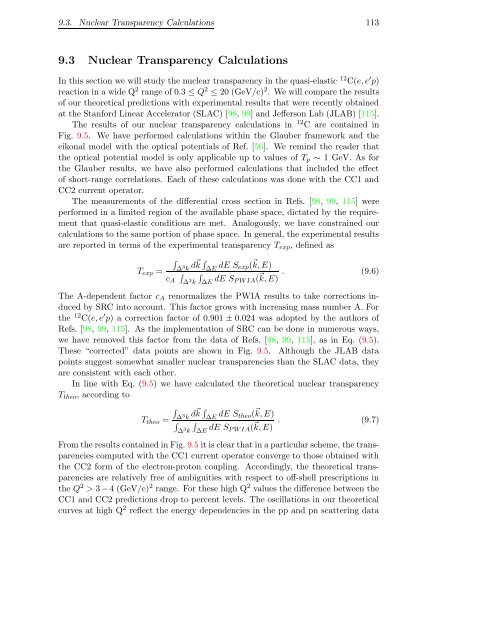Download Thesis in Pdf Format - Theoretical Nuclear Physics and ...
Download Thesis in Pdf Format - Theoretical Nuclear Physics and ...
Download Thesis in Pdf Format - Theoretical Nuclear Physics and ...
You also want an ePaper? Increase the reach of your titles
YUMPU automatically turns print PDFs into web optimized ePapers that Google loves.
9.3. <strong>Nuclear</strong> Transparency Calculations 113<br />
9.3 <strong>Nuclear</strong> Transparency Calculations<br />
In this section we will study the nuclear transparency <strong>in</strong> the quasi-elastic 12 C(e, e ′ p)<br />
reaction <strong>in</strong> a wide Q 2 range of 0.3 ≤ Q 2 ≤ 20 (GeV/c) 2 . We will compare the results<br />
of our theoretical predictions with experimental results that were recently obta<strong>in</strong>ed<br />
at the Stanford L<strong>in</strong>ear Accelerator (SLAC) [98, 99] <strong>and</strong> Jefferson Lab (JLAB) [115].<br />
The results of our nuclear transparency calculations <strong>in</strong> 12 C are conta<strong>in</strong>ed <strong>in</strong><br />
Fig. 9.5. We have performed calculations with<strong>in</strong> the Glauber framework <strong>and</strong> the<br />
eikonal model with the optical potentials of Ref. [56]. We rem<strong>in</strong>d the reader that<br />
the optical potential model is only applicable up to values of T p ∼ 1 GeV. As for<br />
the Glauber results, we have also performed calculations that <strong>in</strong>cluded the effect<br />
of short-range correlations. Each of these calculations was done with the CC1 <strong>and</strong><br />
CC2 current operator.<br />
The measurements of the differential cross section <strong>in</strong> Refs. [98, 99, 115] were<br />
performed <strong>in</strong> a limited region of the available phase space, dictated by the requirement<br />
that quasi-elastic conditions are met. Analogously, we have constra<strong>in</strong>ed our<br />
calculations to the same portion of phase space. In general, the experimental results<br />
are reported <strong>in</strong> terms of the experimental transparency T exp , def<strong>in</strong>ed as<br />
∫<br />
∆<br />
T exp =<br />
3 k d⃗ k ∫ ∆E dE S exp( ⃗ k, E)<br />
c A<br />
∫∆ 3 k<br />
∫∆E dE S P W IA( ⃗ k, E) . (9.6)<br />
The A-dependent factor c A renormalizes the PWIA results to take corrections <strong>in</strong>duced<br />
by SRC <strong>in</strong>to account. This factor grows with <strong>in</strong>creas<strong>in</strong>g mass number A. For<br />
the 12 C(e, e ′ p) a correction factor of 0.901 ± 0.024 was adopted by the authors of<br />
Refs. [98, 99, 115]. As the implementation of SRC can be done <strong>in</strong> numerous ways,<br />
we have removed this factor from the data of Refs. [98, 99, 115], as <strong>in</strong> Eq. (9.5).<br />
These “corrected” data po<strong>in</strong>ts are shown <strong>in</strong> Fig. 9.5. Although the JLAB data<br />
po<strong>in</strong>ts suggest somewhat smaller nuclear transparencies than the SLAC data, they<br />
are consistent with each other.<br />
In l<strong>in</strong>e with Eq. (9.5) we have calculated the theoretical nuclear transparency<br />
T theo , accord<strong>in</strong>g to<br />
∫<br />
∆<br />
T theo =<br />
3 k d⃗ k ∫ ∆E dE S theo( ⃗ k, E)<br />
∫<br />
∆ 3 k<br />
∫∆E dE S P W IA( ⃗ k, E) . (9.7)<br />
From the results conta<strong>in</strong>ed <strong>in</strong> Fig. 9.5 it is clear that <strong>in</strong> a particular scheme, the transparencies<br />
computed with the CC1 current operator converge to those obta<strong>in</strong>ed with<br />
the CC2 form of the electron-proton coupl<strong>in</strong>g. Accord<strong>in</strong>gly, the theoretical transparencies<br />
are relatively free of ambiguities with respect to off-shell prescriptions <strong>in</strong><br />
the Q 2 > 3 − 4 (GeV/c) 2 range. For these high Q 2 values the difference between the<br />
CC1 <strong>and</strong> CC2 predictions drop to percent levels. The oscillations <strong>in</strong> our theoretical<br />
curves at high Q 2 reflect the energy dependencies <strong>in</strong> the pp <strong>and</strong> pn scatter<strong>in</strong>g data















